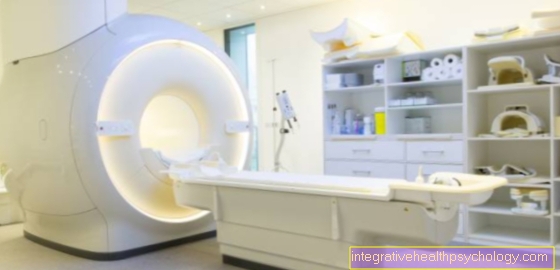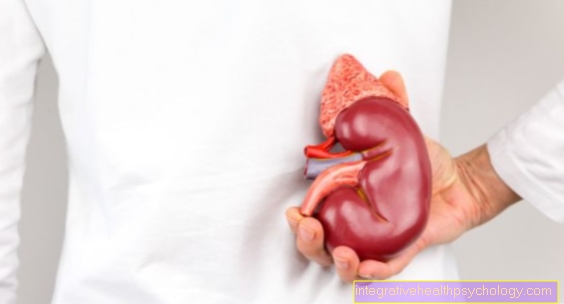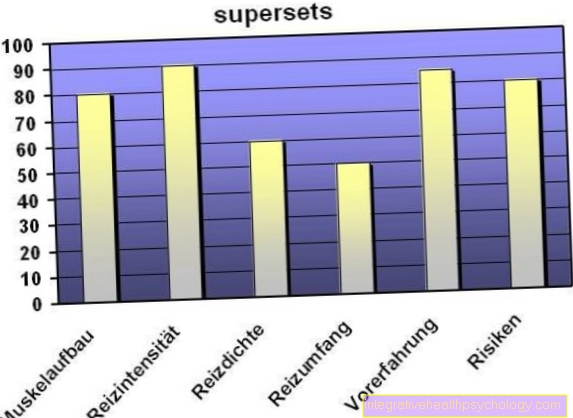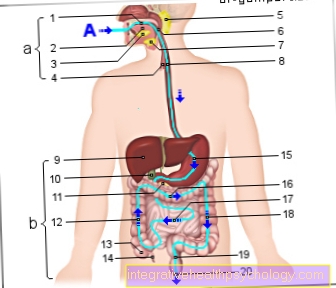Bruised ribs
definition
A rib bruise, also known as a rib bruise, is an injury to one or more ribs caused by external forces such as a fall or a traffic accident. In contrast to a broken rib, the bones are not injured when the rib is crushed. However, squeezing soft tissue usually leads to severe pain, which occurs particularly when inhaling deeply.
A bruised rib usually heals without any consequences, but this can take several weeks. A bruised rib and a broken rib cannot always be clearly differentiated based on symptoms alone.

causes
A rib bruise can result from direct blunt force, which can have various causes. The ribs are relatively sensitive to pain, as the bones are for the most part only protected by a thin layer of soft tissue made up of skin and subcutaneous fatty tissue. In contrast to a broken rib, the bony structures remain intact, but the soft tissues are crushed, which is usually very painful.
A rib bruise can be caused, for example, by falling on the chest while cycling or climbing stairs. Other causes can be a kick, a punch or if you hit an edge. The causes of bruising in the ribs are therefore particularly common in sports that involve a lot of physical activity such as handball, ice hockey and most martial arts such as boxing, wrestling or judo.
Another common cause of bruised ribs is traffic accidents. A common injury pattern is that in a rear-end collision, the driver's chest hits the steering wheel.
These symptoms indicate a bruised rib
The symptoms of a bruised rib usually set in immediately after the triggering event. In some cases, such as in a serious traffic accident or when exercising, the perception of pain can initially be dampened by a high level of adrenaline, so that the symptoms only appear later. Pain in the affected area of the chest is the main symptom by which one recognizes a possible bruised rib.
These are usually only localized on one side and, depending on the extent of the injury, limited to one area. Typically, the symptoms are aggravated by coughing and may be more noticeable even when taking a deep breath (see also: Pain on inhalation). Many people with very painful rib bruises therefore breathe very shallowly in order to avoid the pain as much as possible. However, this can in turn lead to shortness of breath for the person concerned.
Another symptom that may indicate a bruised rib is a bruise mark on the skin where the injury was sustained. It is a bruise (Hematoma), which occurs when small blood vessels have been destroyed when the ribs are crushed and the tissue has hemorrhaged.
However, as a layperson it is usually not possible to differentiate between a bruised rib and a broken rib, as the symptoms can be very similar. Therefore, if in doubt about the symptoms described, a doctor should be consulted so that an examination can determine whether ribs are broken or whether the ribs are simply crushed.
diagnosis
In order to diagnose a bruised rib and in particular to differentiate it from other injuries such as a broken rib, the doctor will first ask the patient a few questions and then examine him specifically. The doctor will ask how the accident happened. He would also like to receive information from the patient about the localization, severity and breathing dependency of the pain. In addition, any previous illnesses or previous accidents as well as any medication taken should be reported to the doctor.
The next step is the physical examination, during which the affected area is viewed and gently palpated. The examiner looks for bruise marks, whether the pain can be reproduced by pressure and whether there are any signs of bone instability. If the doctor suspects on the basis of the examination that a broken rib could be behind the symptoms, he will usually order an X-ray examination of the ribs.
Often the rib bruise remains as a diagnosis of exclusion if pain occurs in the area of the chest as a result of an injury, but a broken rib could not be detected.
therapy
In the case of bruised ribs, treatment is primarily based on relieving the symptoms. Pain can be relieved by temporarily cooling the affected area. However, a thin towel should always be placed between the skin and the coolant and should not be cooled continuously to prevent the skin from freezing.
In addition, physical restraint should be observed and sport should be avoided as long as the bruised ribs cause symptoms. However, no bed rest should be kept, but gentle exercise, for example by going for a walk. If necessary, your general practitioner can give advice on the right amount of exercise.
If the ribs are crushed, temporary therapy with an anti-inflammatory pain reliever in the form of tablets may also be indicated. This is especially important if the pain is preventing you from breathing deeply due to the bruised ribs. Failure to breathe easily as a result of this can otherwise lead to pneumonia, especially in older people.
Duration
The length of time that a bruised rib causes discomfort can vary widely and depends primarily on the type and intensity of the causal injury. In the case of light shapes, for example if you bump into an edge or a piece of furniture in everyday life, the duration is usually limited to a few days.
However, if the cause was a traffic accident or a violent collision while exercising, the pain from the bruised ribs can persist for many weeks and months. The duration also partly depends on the behavior of the person concerned. Anyone who spares themselves physically with a bruised rib and occasionally cools the affected area is less likely to have symptoms for a long time than someone who continues to do sports with high physical exertion.
However, even if it has been present for a long time, a bruised rib usually heals without long-term physical complaints.
These alternative diseases produce similar symptoms
The alternative disease that primarily needs to be demarcated when the rib is crushed is the fracture of one or more ribs. Neither the course of the injury nor the symptoms perceived allow any reliable distinction. As a rule, certainty can only be obtained through a medical examination, which may also include an X-ray of the ribs.
Another condition that manifests itself as chest pain, especially when breathing in and coughing, is pleurisy. This can occur in conjunction with pneumonia, for example, with high fever and fatigue as symptoms.
Other alternative diseases that cause symptoms similar to those of a bruised rib can originate from the back and radiate forward. For example, irritation of a nerve due to muscular tension or incorrect movement can cause unilateral pain in the rib area.





























